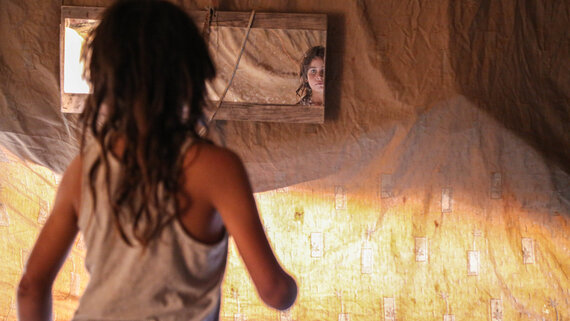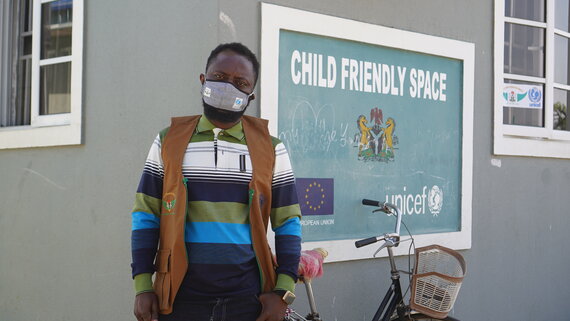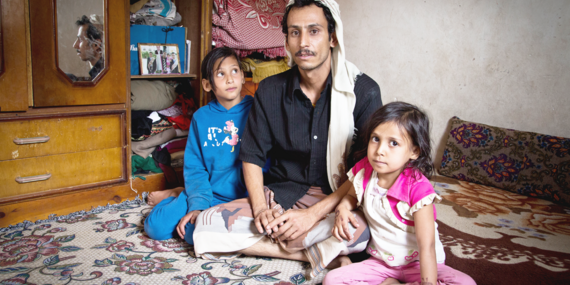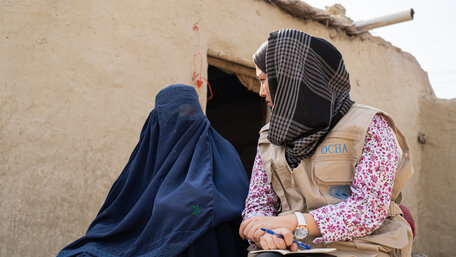Sana'a, Yemen
This young father from Yemen keeps a brave face for his wife and three daughters. He cannot afford rent or much food for his family. He says of his children: "They know our situation, they rarely ask for anything. If one of them wanted something and I said I had no money, they accept and just walk away." After years of escalating conflict, Yemeni people continue to bear the brunt of ongoing hostilities and severe economic decline. In 2021, OCHA’s pooled funds allocated more than $96 million to fund 70 humanitarian projects in Yemen. WFP/Marco Frattini
The Central Emergency Response Fund (CERF) and the Country-based Pooled Funds (CBPFs) remain key instruments that ensure coordinated and principled humanitarian assistance quickly reaches people caught up in crises.
As of 28 October, CERF has allocated over $491 million directly to 36 countries. The CBPFs have allocated $506 million to 19 country contexts (see table below). Eleven UN agencies have received CERF funding, targeting 50 million people.
Allocations of Pooled Funds per country
Apart from UN agencies, CBPFs funds in 2021 benefited 260 international NGOs, 196 national partners and four Red Cross/Red Crescent national societies, targeting 59.1 million people.
Top contributions to Pooled Funds
OCHA’s pooled funds trialled several important innovations in 2021:
Regionally hosted pooled fund. This concept was developed building on the success of the CBPFs approach. It mirrored many of the CBPFs’ practices and consisted of a series of funding “envelopes” for countries within the region. Regional funds will introduce greater agility and stability to the provision of pooled fund services. The fund launched its first country envelope in Niger ($14 million) following endorsement by the ERC and a director-level round table. This allocation was made in view of the country’s large and deteriorating humanitarian crisis, with 3.8 million people in need of assistance in 2021, the highest figure in five years.
GBV programming received a special allocation of $25 million from CERF’s Rapid Response window. Under this allocation, UNFPA received $17 million and UN Women $8 million, with the requirement that at least 30 per cent of the funding be passed through to women-led organizations working on GBV. An independent review found that CERF’s designation of a GBV-specific allocation was key to increasing attention for GBV in humanitarian settings. The review also underlined the considerable value of the block grant approach, its multi-country nature and the unique opportunity it provides for countries to apply global guidance across multiple settings.
People living with disabilities received targeted support through a dedicated disability envelope in 2021. The ERC allocated $10 million to seven countries (Afghanistan, Colombia, DRC, Nigeria, South Sudan, Syria and Venezuela) participating in CERF’s first Underfunded Emergencies round. This was in addition to $125 million allocated to all 12 countries participating in the round (Afghanistan, Burkina Faso, Cameroon, Chad, DRC, Ethiopia, Madagascar, Mozambique, Nigeria, South Sudan, Syria and Venezuela). All CERF-funded projects are expected to mainstream support for persons with disabilities, taking into consideration their specific needs. Work in support of people living with disabilities was informed by an Inter-Agency Disability Contact Group, which OCHA created in 2021. An independent review will assess the initiative in 2022.

Maarrat Misrin, Syria
This 10-year-old boy was one of a number of people injured two years ago when an airstrike targeted a village to which he and his family had been displaced. Before this, the family lived in the southern countryside of Idlib. He moved to Turkey for treatment and he is currently residing in the Al-Ghadfa camp near Maarrat Misrin.
OCHA/Bilal Al-HammoudNotable Allocations
In 2021, weather events, conflicts, disease outbreaks and the impacts of COVID-19 continued to contribute to high levels of humanitarian needs. Several countries were struck by new emergencies, while others witnessed deteriorating humanitarian conditions that required support from OCHA’s pooled funds.
In response to the rapidly deteriorating situation in Afghanistan and Ethiopia, several time-critical CERF and CBPFs allocations have been approved since December 2020 by the ERC and the relevant HC for an overall amount of more than $276 million.
Support to local and national actors
CBPFs have become a key vehicle for supporting direct funding to local and national actors. In 2021 CBPFs allocated $138.5 million to local and national NGOs (27 per cent of total CBPFs funding), continuing to be the largest source of direct funding for such organizations. The Syria Cross-Border Fund provided $50.3 million to local and national NGOs, accounting for 50 per cent of their $101 million allocation in 2021.
While localization is recognized as a secondary aim of CBPFs, their overarching goal remains to support partners best placed to respond in a timely, efficient and accountable manner. OCHA has sought to empower local actors with greater agency in shaping the humanitarian response and promoting local solutions, such as by increasingly involving them in the governance of funds, providing higher-quality funding to local actors and providing capacity support.
In 2019, UN agencies engaged 588 local and national partners in the implementation of CERF funding, the highest number ever recorded. This included 377 national or local NGOs, 196 Government entities and 15 Red Cross/Red Crescent societies. The majority of sub-granted CERF funding ($73 million, or 14 per cent of annual CERF funding) went to national and local partners in 2019.

Chad
A UNICEF project, sponsored by CERF, has brought hope for youth affected by violence, whilst also tackling protection and economic empowerment. One hundred young people are learning how to build filters, fix water points, make soap and build latrines to improve sanitation in the Lake Chad region. The project aims to respond to the immediate needs of the population, access to clean water and promotion of good hygiene practices. It also integrates protection through WASH activities by providing skills development opportunities to youth abducted by Boko Haram. These skills can then support the youth with income generation revenue activities.
UNICEF/BahajiProtection from Sexual Exploitation and Abuse
CBPFs use targeted allocations to contribute to PSEA efforts. The DRC Humanitarian Fund supported the implementation of the National PSEA Strategy through an allocation made in March 2021. This provided support to a PSEA network at national and regional levels and strengthened community engagement, including public awareness and sensitization, case management and survivor assistance. In June, the fund supported PSEA training for humanitarian actors.
Similarly, a May 2021 allocation to the Sudan Humanitarian Fund established safe spaces for women and girls in underserved areas, upgraded services for GBV survivors and promoted PSEA work. OCHA mainstreams PSEA approaches across funded projects. For example, it requires that pooled-funding recipients develop and maintain appropriate mechanisms for reporting and addressing SEA-related complaints.
Accountability to Affected People
OCHA is committed to promoting AAP. Pooled-fund recipients are required to consider the appropriate operational steps for engaging with affected communities when developing and implementing projects, and AAP measures must be demonstrated throughout the programme cycle.
The CERF secretariat ensures that IASC commitments are tracked through project proposals, and it collects information on joint AAP mechanisms at the allocation level. These should capture inter-agency feedback-and-complaints mechanisms, benefiting the entire humanitarian response in each country operation. CERF also tracks agency-specific feedback-and-complaints mechanisms through project documents. AAP output indicators have also been included in a recently developed list of CERF standard indicators.
CBPFs have included AAP across the different stages of the allocation cycle. At the fund level, allocation strategy papers ensure AAP mainstreaming. Under the existing CBPFs global guidelines, all funds are required to implement a feedback mechanism that can be used by affected people, and allocations are requested to demonstrate how they strengthen response-wide collective AAP. Allocations can include targeted support to AAP efforts. For example, the Syria Cross-Border Fund supported improved monitoring and community consultations to strengthen AAP in a March 2021 allocation. At the partner level, capacity assessment questionnaires require partners to demonstrate AAP policies and proof of their implementation.
The Centrality of Protection
OCHA recognizes that protection is one of the main purposes and intended outcomes of humanitarian action. The protection of all people affected and at risk informs humanitarian decision-making and is an integral part of the responses funded by OCHA’s pooled funds.
CERF funding to the protection sector reached $75 million during the first 10 months of 2021. This represented over 15 per cent of all CERF funding during the year, compared to 2020 when 10 per cent (or $82 million) of all funding went to the protection sector. The number of people targeted with CERF-funded life-saving assistance in the protection sector reached 2.8 million in 2021, of whom 1.7 million (or 60 per cent) were female.
CBPFs allocated $65.6 million to protection activities (13 per cent of total funds allocated), targeting nearly 4.6 million people in need. In particular, CBPFs provided $8.7 million to support child-protection activities in different emergencies.

Stadium IDP Camp, Nigeria
UNICEF, in partnership with local NGO Goal Prime and CERF funding, has set up a Child Friendly Space to help children in this IDP camp continue having an education and a safe space where they can play, learn and have access to clean water. They also receive psychosocial support. Children here come from various villages and towns in Borno State. Some are displaced with their families, but some others have lost their families and went through trauma. The center helps children who were forcibly recruited by non-state armed groups recover and rebuild a normal childhood and social life. Adults and caregivers also receive support in this center.
OCHA/Eve SabbaghGender equality and gender-based violence
In 2021, gender equality and support to GBV continues to be an important focus area for OCHA’s pooled funds. OCHA established an inter-agency Gender Contact Group that explored ways for OCHA’s pooled funds to strengthen their support to women and girls.
The CBPFs allocated $385 million (around 76 per cent of total allocations) to projects that intend to contribute to gender equality with consideration to age groups. This is in line with the IASC Gender with Age Marker (GAM) assessment. Of the 59 million people targeted by CBPFs' partners partners, 630.7 million are women and girls (52 per cent). CBPFs have allocated $15.6 million to projects that include GBV programming. CBPFs actively promote the participation of women in governance arrangements. Across the 19 funds, women represent international NGOs in 19 advisory boards and national NGOs in 11 advisory boards.
Gender also continued to be a priority for CERF in 2021. All submissions were informed by a gender analysis, with data disaggregated by sex and age, and they had completed the mandatory GAM. Of the 97 million people targeted with life-saving assistance through CERF in 2021, approximately 53 per cent were women and girls. CERF also actively promotes the concerns of women and girls through targeted allocations, such as GBV earmarking in allocations from its Underfunded Emergencies window in 2020. In addition, CERF provided $25 million in block grants to UN Women and UNFPA to combat GBV. At the time of writing, CERF remains the single largest direct funder towards the GBV sub-sector, with $35 million provided so far in 2021. Similarly, CERF was the largest direct donor to GBV, with $28 million in total funding.
Allocations by Gender and Age Marker
Anticipatory Action
In recent years, the humanitarian community has actively pursued ways to help people get ahead of predictable crises by taking anticipatory action. In 2021, OCHA continued to coordinate, facilitate and mobilize resources for collective anticipatory action. OCHA-managed pooled funds have played a catalytic role. CERF financed collective anticipatory action ahead of drought in Ethiopia and Somalia, allocating $20 million in each country. This brings its total anticipatory allocations to $60 million since June 2020.
OCHA currently facilitates collective anticipatory action pilots in 11 countries and in one thematic area (cholera).
Further reading
Source: OCHA
Source: OCHA
Source: OCHA
References
- CBPF beneficiary figures are calculated on a project-by-project basis which may lead to some people being counted more than once. The above figures is, therefore, a preliminary estimate. A comprehensive review of beneficiary figures is undertaken on a yearly basis prior to the publication of final figures in the CBPF annual report.
- In response to the escalating conflict in Tigray, Ethiopia, the ERC approved a time-critical CERF allocation of $13 million in December 2020 following conflict escalation. CERF released another $15 million in June 2021 to assist the most affected communities in the region following improved access for humanitarian operations. This was complemented by an allocation from the Ethiopia Humanitarian Fund, which provided a reserve allocation in March 2021 of $2 million to expand humanitarian access; a standard allocation of $45 million in April in response to the situation in Tigray and the risk of climate- and weather-related events; and a reserve allocation of $20 million in August to enable a scale up of the humanitarian response in Tigray, Afar and Amhara regions. Support from OCHA’s pooled funds was also instrumental in responding to the rapidly deteriorating situation in Afghanistan. At the beginning of 2021, over 18 million people—almost half of the country’s population — needed humanitarian assistance. During the first six months of the year, an additional 550,000 people were forced into displacement. To respond to the fast-evolving context, CERF has allocated over $90 million to humanitarian responses in the country in 2021, including $20 million in August from the Rapid Response window to enable the Afghanistan country team to “stay and deliver” and maintain and scale up the humanitarian response. In September, CERF released another $45 million from the Rapid Response window to prevent a collapse of the country’s health-care system and ensure continued provision of life-saving health services. Similarly, the Afghanistan Humanitarian Fund released a $3.1 million reserve allocation in February 2021 to provide air transportation, expand humanitarian access, and facilitate security relocations and medical evacuations. This was followed in May by a $20 million reserve allocation to respond to intensifying conflict, combined with weather-related disasters. Lastly, in August 2021, the Afghanistan Humanitarian Fund approved a reserve allocation of close to $23 million to scale up life-saving programmes, an innovative rolling allocation designed to approve proposals on an ongoing basis in response to a rapidly changing situation.
- 2019 is the most recent year for which complete data is currently available.
- CERF allocations to protection in 2020 totaled $82 million, but this figure covers the entire 12-month period of the year. 2021 figures cover the 10 months until end October.
- CERF: Allocations by Sector 2021
- Financial Tracking Service, Protection - Gender-Based Violence 2021 as of 2 November 2021
- Financial Tracking Service, Protection - Gender-Based Violence 2020 as of 3 November 2021.
- $15 million for Somalia in 2020; $5.2 million for Bangladesh in 2020; $20 million for Ethiopia in 2020/2021; $20 million for Somalia in 2021.





